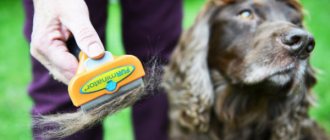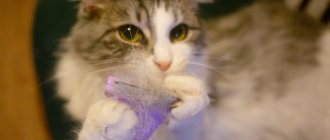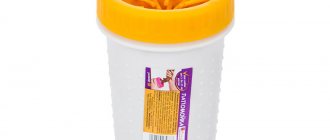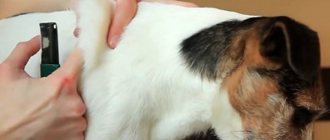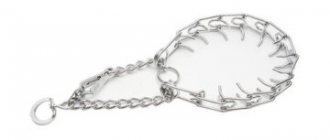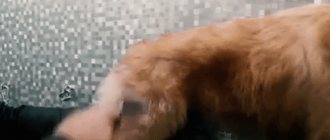| Place | Name | Characteristics in the rating |
| The best furminators for dogs |
| 1 | FURminator | The best furminators for dogs of all breeds |
| 2 | Hello Pet self-cleaning 42465M | The most comfortable model for medium-sized dogs |
| 3 | Trixie 24173 | Ideal for matted fur |
| 4 | Foolee One Large | Especially for large breeds |
| 5 | MARKETHOT Z00144 | High efficiency at a competitive price |
| The best furminators for cats |
| 1 | FURminator | The best furminator for large long-haired cats |
| 2 | Furminator Deluxe Medium | The best option for short-haired cats |
| 3 | Foolee One Medium | Universal option for cats and dogs |
| 4 | BEEZTEES SMALL | Possibility of blade replacement |
| 5 | BEEZTEES 2 IN 1 SMALL | Low price and efficiency |
Owners of furry pets know firsthand what shedding is. Dog and cat hairs end up everywhere - not only on the floor, carpets and upholstered furniture, but also on clothes, bedding, towels, and sometimes even dishes. Special grooming devices help reduce the severity of shedding and speed up its progression. At home, the furminators that are most often used are easy-to-use furminators, which are a trimmer comb with very fine teeth. But since their selection in pet stores is quite large, we suggest you familiarize yourself with the rating of the best models.
Device types
Tools differ from each other not only by manufacturer, but also by other criteria. When purchasing, it is important to consider the size of the animal and the length of the coat, as these factors affect the length and shape of the teeth.
Depending on the size of the pet
Basic models are presented in only 3 types. These include:
- Small. Equipped with a blade up to 4.5 cm. Designed for small short-haired dogs. The weight of the animal should be between 5-9 kg.
- Medium. A universal option with 6-7 cm blades, suitable for most four-legged animals weighing 10-25 kg.
- Large. This Furminator is recommended for large dogs weighing 25-40 kg. The length of the blades is 10-10.5 cm.
Owners of dwarf and giant breeds will have a little more difficult time. For their pets, the rarer Extra-small, or X-small, and Extra-large, or X-large models are suitable. The length of their blades is 3 and 12.5 cm, respectively. The first option is recommended for animals weighing less than 5 kg, and the second for animals weighing more than 40 kg.
Depending on the pet's fur
In addition to the listed models, there are two more types: Long and Short. The first has elongated and sparsely spaced teeth, while the second has shortened and tightly adjacent teeth.
“
The choice depends on the length of the dog's coat. If it exceeds 5 cm, take Long, and if it is short enough, give preference to Short.
Please note that the line of accessories called FURminator FURflex fits any length. This option will be useful for owners of several pets with fur of different lengths. To save money, you can take only one tool for all four-legged animals.
How to use a furminator correctly
To obtain the desired effect, you must strictly follow the instructions, observing the frequency of procedures and the immediate combing algorithm. Proper instrument care is equally important. Otherwise, it will quickly fail.
Frequency
The device captures up to 90% of fallen fluff, so it is enough to use it only 2-3 times a month during shedding. Exceptions include breeds with a thick undercoat. It is recommended to comb them 1-2 times a week, regardless of the time of year. In case of particularly heavy shedding, this frequency can be temporarily increased.
Progress of the combing procedure
You need to get used to grooming from childhood, so that an adult dog can calmly endure prolonged manipulations and not interfere with your work. In addition to education, two more points should be taken into account: a full stomach and pleasant fatigue.
Before brushing, be sure to go for a walk and feed your pet. After this, carefully comb the fur with a regular comb, untangle the tangles with your hands or remove them with a tangle cutter. Then wash your dog with shampoo and dry thoroughly with a hairdryer.
Having dealt with the preparatory stage, feel free to proceed to the main thing:
- Place your pet on the floor or table, take the device and begin combing the fur, moving in the direction of its growth. Perform all actions smoothly and carefully, avoiding pressure.
- Process each area 2-3 times, constantly cleaning the blades of any fluff that accumulates on them.
- Move from head to tail. Please note that the nerve endings on the belly, hind legs and tail are highly sensitive. When combing these areas, reduce the force of exposure to eliminate the occurrence of unpleasant sensations.
At the end of the procedure, take a soft-bristle brush and walk it over the entire body. It will help remove remaining hairs.
What is the effect?
After 2-3 sessions, it will be possible to reduce the frequency of general cleaning, since there will be much less wool balls on the floor. In addition to reducing the amount of fallen fluff, the procedure will also have another effect. Thanks to regular massage and distribution of fatty lubricant over the entire surface of the body, your pet’s blood circulation will be normalized, and its coat will shine with a beautiful shine.
Instrument care
After the procedure, the device must be washed in warm, non-soapy water and dried thoroughly with a paper or regular towel. Sponges and wet wipes can dull the razor, so it is better not to use them.
Please note that a special cap is provided to protect the working surface. Be sure to put it on the blades and do not remove it until the next session.
Criterias of choice
By comparing all the available types of tools with the characteristics of your pet, you can confidently make a choice. What you need to determine before purchasing:
- pet's hair length - it is better to measure with a ruler;
- weight and dimensions - if in doubt, choose a furminator with a narrower blade to reach the lint in hard-to-reach places;
- how much money are you willing to spend - the Deluxe class costs one and a half times more, but it is incomparably more convenient.
Pay attention to the country of origin. Do not buy questionable products - they may be of poor quality and therefore dangerous for your pet.
How to choose a furminator for dogs
When purchasing, it is recommended to take into account the technical characteristics and ease of use. To do this you need:
- Choose the correct size of teeth and width of the working surface, based on the characteristics of your pet.
- Make sure there are no irregularities or other deformations (burrs, roughness).
- Check for the presence of raised rubberized inserts on the handle and be sure to hold the accessory in your hand.
It is also worth paying attention to the presence of a quick cleaning button and self-sharpening blades. These functions will simplify the work with the accessory and extend its service life.
What is it intended for and who is it suitable for?
The tool is designed to prevent tangles and reduce the duration of seasonal shedding. It quickly removes accumulated fluff without causing pain or discomfort to the animal.
The device is suitable for breeds with a thick and well-developed undercoat:
- setters;
- husky;
- bobtails;
- spaniels;
- shepherd dogs;
- retrievers;
- St. Bernards;
- huskies.
By combing out excess hair, natural heat exchange is maintained and new hair growth is stimulated. This eliminates overheating in hot weather or hypothermia in the cold season.
What are the advantages and disadvantages of a detangling comb?
The Furminator for dogs has a number of undeniable advantages:
- As numerous reviews indicate, this brush for dogs reduces the shedding process by about 90%.
- This tool allows you to quickly comb out the animal's fur several times a day during shedding, thereby reducing the time spent caring for the animal.
- Thanks to the use of the device, the formation of tangles is prevented and fur can be removed thoroughly. As a result of all manipulations, your pet is left with a shining “fur coat”.
Important point! A dog comb has a significant drawback - the price. Such a purchase for your dog will not be cheap, although it also matters what type of coat the purchase is made for. However, today there is a special comb for dogs on sale that performs two functions at the same time.
The result of using a furminator is to rid the animal’s fur coat of excess hair.
For those who prefer not to spend a lot of time combing their pet, it is better to purchase the appropriate tool, although this will not be cheap.
Your dog will no longer have problems associated with constantly falling off tufts of fur. This applies to both long-haired and short-haired dogs. And you don’t have to constantly clean the house after your pet.
Show Tech (Belgium)
The trimming stone looks like pumice, and the surface is just as porous. A rectangular tool, used for plucking dead hairs at the final stage of processing soft coats and undercoats (spaniels, setters). According to reviews from dog owners, this tool copes with the task well, but black dust from the stone remains everywhere. Costs about 300-400 rubles.
When not to use the tool
Despite its advantages, the accessory also has a number of contraindications. Restrictions on use are imposed if the coat type is unsuitable and in the presence of certain diseases or injuries.
Breeds that should not be scratched with a furminator
It is prohibited to comb animals with long, thin and silky hair, such as lapdogs, Yorkies, Shih Tzus and Afghan hounds. Blades of such great length are simply not available.
Also, you should not use the tool if the dog has curly and rough fur (poodles, Airedales, Komondors). When combing, it catches and smoothes the hairs, removing the curls inherent in the breed.
The main task of the product is to remove undercoat. For this reason, it is simply pointless to use it for combing smooth-haired (dachshunds, bulldogs, Dobermans) and completely hairless (Chinese Crested, Peruvian dogs) breeds.
Temporary contraindications
Temporary contraindications include multiple tangles, any damage to the skin and dermatological diseases. If your pet is injured or suffers from eczema, postpone brushing until it recovers. Otherwise, you will only hurt him and make the existing problem worse.
At home or in the salon?
You can cut your Chihuahua's hair either in a salon or on your own.
However, if an exhibition is planned, the pet will definitely have to undergo full grooming in the salon. But this is not enough. Before entrusting your dog to a groomer, take an interest in his portfolio, talk to dog owners (his clients), and read reviews.
If you want to get the perfect result, look for grooming salons only based on recommendations from real clients.
If the dog requires a cosmetic (hygienic) haircut, then it can be done at home. This requires two conditions - a good tool and skill.
Expert advice
Groomers, breeders and experienced owners use dog brushes almost every day. They know how to choose the right instrument, how to care for it, and share tricks with beginners. These tips will help you avoid mistakes in purchasing and using brushes:
- After purchasing, try a clean and new brush on yourself. If you experience discomfort, stop using it. Afterwards, be sure to rinse the instrument and disinfect it.
- Do not use the same brush for all pets. Rinse and disinfect it after each use.
- Dogs of small and medium breeds are often suitable for brushes designed for cats with long hair.
The range of dog grooming brushes allows you to choose one or more ideal models, even for difficult-to-groom dogs. Cost also contributes to this, as does the durability of quality products. There is not a single dog that can do without a brush; even completely “naked” dogs need to be treated with a massage rubber mitten or glove. And, what is very important, the habit of brushing your pet becomes a pleasant time together after just a couple of weeks!
How much do groomer services cost?
When talking about grooming prices, you should definitely take into account the region and level of the salon.
So in Moscow and the Moscow region, prices for a haircut range from 1200 to 1800 rubles. Combing will cost about the same. Prices for comprehensive grooming can vary from 2000 to 5000 rubles, and sometimes higher.
What is included in the service package:
- bathing;
- blow drying;
- a haircut;
- combing;
- nail trimming;
- teeth cleaning;
- ear cleaning;
- eye care.
Is this a replacement for a haircut?
Some owners of wire-haired dog breeds believe that trimming and cutting are the same thing, without delving into the meaning of the procedures. These methods of processing wool have different purposes, so it cannot be replaced by cutting.
Trimming is a forced hygienic procedure that helps remove dead hairs, thereby ensuring the growth of new hairs with the correct structure.
During the cutting process, only the tops of the coarse guard hairs are removed down to the base, but the structure of the coat changes greatly. The cut hair with a thin base continues to grow and the animal eventually breaks into soft downy thin hair. Even a single haircut of a dog can lead to irreversible consequences and loss of the type of coat characteristic of the breed.
